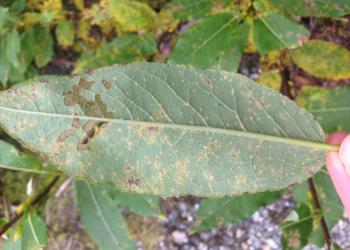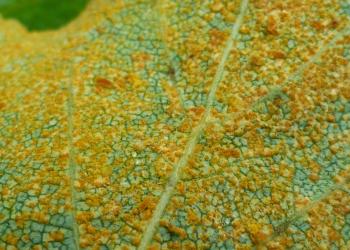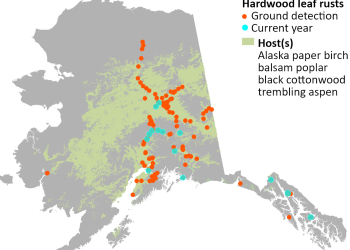Hardwood Leaf Rusts
Host(s) in Alaska:
Birch species (Betula spp.)
Black cottonwood (Populus trichocarpa)
Willow species (Salix spp.)
Habitat(s): hardwood leaves and conifer needles
General Distribution in Alaska: Throughout the range of hardwood hosts statewide
Rust specimen collections from Alaska are important, as pathogen and host ranges continue to become clarified with molecular characterization. The DNA extracted from a rust on willow matched that of both Melampsora paradoxa and Melampsora humboldtiana with >99% identity in the rustHUBB database (Oregon State University Diagnostic Clinic). Further research and additional loci sequencing to differentiate between the two species will be conducted by the Cathie Aime Lab (Purdue University).
2024 Ground Detection Survey Observations: 23 observations, from Fairbanks and the Alaska range south to Anchorage, Cordova, and Southeast on willow, birch, alder, and black cottonwood. Hardwood leaf rusts were not detected during aerial detection surveys or as iNaturalist research grade observations this year.
Distinguishing among the species that cause hardwood leaf rusts was previously considered entirely dependent on the host plant: Melampsora epitea on willow, M. medusae on poplars, including aspen, and Melampsoridium betulinum on birch (but is known to alternate on larch in Europe). However, it is now understood that there is enough molecular and pathogenic variation in Melampsora epitea of willow that it is now considered a species complex rather than a single species (Bennett et al. 2011, Mycologia,103(5), 2011, pp. 1004–1018).
Orange spores are produced on the undersides of leaves in late summer, causing yellow, mottled leaf discoloration and blight symptoms on various hardwood hosts. Affected birch, cottonwood and willow display yellow to brown discoloration of leaves or entire tree or shrub crowns.
For some species and races of hardwood leaf rust, spores produced on hardwoods infect needles of susceptible conifers in late summer. Damage to hardwood and conifer hosts is usually ephemeral, since infected leaves are replaced the following year and weather conditions are not normally conducive to widespread or severe disease across consecutive years. This disease is not considered serious in Alaska and is not actively managed.
This disease rarely occurs at severe enough levels to warrant mention in Alaska Forest Health Conditions Reports. The most recent pronounced activity occurred in 2014, when leaf discoloration symptoms were common on various hardwood hosts, especially birch trees, throughout Alaska in late-summer. Symptoms ranging from scattered infected leaves to entirely yellow crowns were widespread across much of Southcentral and Interior Alaska (Matanuska-Susitna Valley, Glenn Highway, and Upper Copper River Valley). Individual heavily-infected birch trees were also observed scattered near Glacier Bay National Park. Along the western coast of Alaska (near Kotzebue), there were several reports of rusted willow leaves. Many residents in Southeast Alaska complained of pollen allergy-like symptoms coinciding with rust spore production on willow and cottonwood. Prior to 2014, the only other year with significant reported hardwood leaf rust activity was 1998. At this time, Melampsora epitea caused moderate to severe damage to willows in the Interior, especially on the Upper Yukon River flats, coinciding with a large outbreak of willow leaf blotch miner.

Severe outbreaks (or severely infected individual trees) can be mapped by aerial survey. Most observations of this disease are informal.
Bennett, C.; Aime, M.C.; Newcombe, G. Molecular and pathogenic variation within Melampsora on Salix in western North America reveals numerous cryptic species. Mycologia. 2011 Sep-Oct;103(5):1004-18. doi: 10.3852/10-289. Epub 2011 May 10. PMID: 21558505. Available here.
Melampsora Rusts: Common leaf rusts of poplars and willows. U.S. Forest Service Rocky Mountain Region. 2011. Available here.
Content prepared by Robin Mulvey, Forest Health Protection, robin.mulvey@usda.gov













